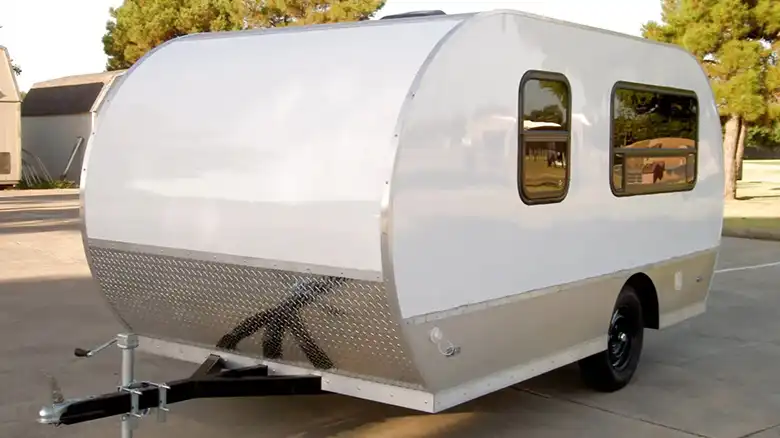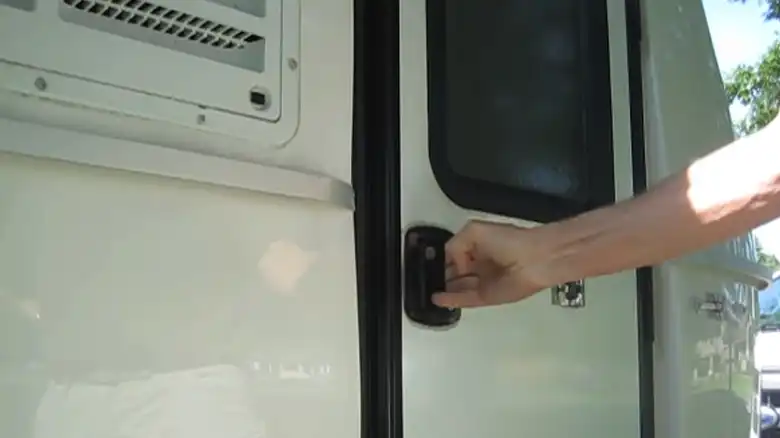Traveling across the country in an RV or camper can be an amazing experience, full of adventure and new discoveries. However, one major concern for RV owners is the damage that can occur from severe weather events, especially hail storms. As an RV expert who has experienced my fair share of hail damage, I’m often asked – how much hail damage does it take to total a camper?
I understand how heartbreaking it is to discover hail damage on your rig. Based on my years of experience in the RV industry, I can provide some general guidelines on when hail damage is likely to total a camper. Hail storms can wreak havoc on RVs, damaging the roof, siding, windows and more.
Let’s explore what it really takes to total out a camper after a hail storm.
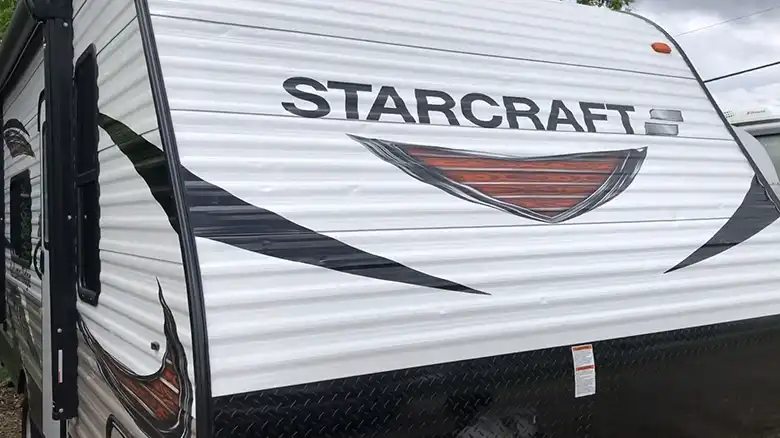
What Factors Determine If Hail Damage Will Total an RV?
When it comes to hail damage on a camper, insurance adjusters will carefully analyze these key aspects:
Hailstone Size and Its Impact on Your RV
Larger hailstones cause more severe damage upon impact. Hail is categorized by diameter size:
- Pea-sized: 1/4 inch
- Marble sized: 1/2 inch
- Golf ball sized: 1 3/4 inches
- Baseball sized: 2 3/4 inches
- Softball sized: 4 1/2 inches
Hail 3/4 inch in diameter (marble size) or greater can start to cause noticeable damage. Stones 1 inch or more can cause serious dents, while hail 2 inches or more can total a camper in minutes.
Duration and Density of the Storm: Key Elements to Consider
The longer the hail storm, the higher the concentration of hail strikes in a given area. A brief, scattered storm will cause less damage than one stationary over an area for 30 minutes. The density of hailfall is also a factor. Was it an intense barrage or intermittent strikes?
Type of RV Exterior and Its Resistance to Hail
Fiberglass exteriors tend to resist hail damage better than aluminum or sheet metal siding. However, once the gel coat is compromised, underlying damage can still occur.
Type of RV Exterior and Its Resistance to Hail
Hail damage concentrated on one section generally causes less structural damage than if the entire roof and sides are peppered with dents. The most problematic areas are the roof, hood, and sides since they are the largest flat expanses.
Hail Damage Thresholds for Specific Areas of Your Camper
Now let’s break down the typical hail damage thresholds by individual areas of the RV exterior:
Roof
As a broad guideline, if more than 50% of the roof area is marked by hail dents, the structural integrity may be compromised and the insurance company will likely total the camper. High concentrations of strikes can cause water leaks, AC unit issues, and failing roof membranes or coatings.
Extensive roof damage also makes complete repair very difficult, since a new roof would likely be required. The time and materials alone could exceed the value of an older RV.
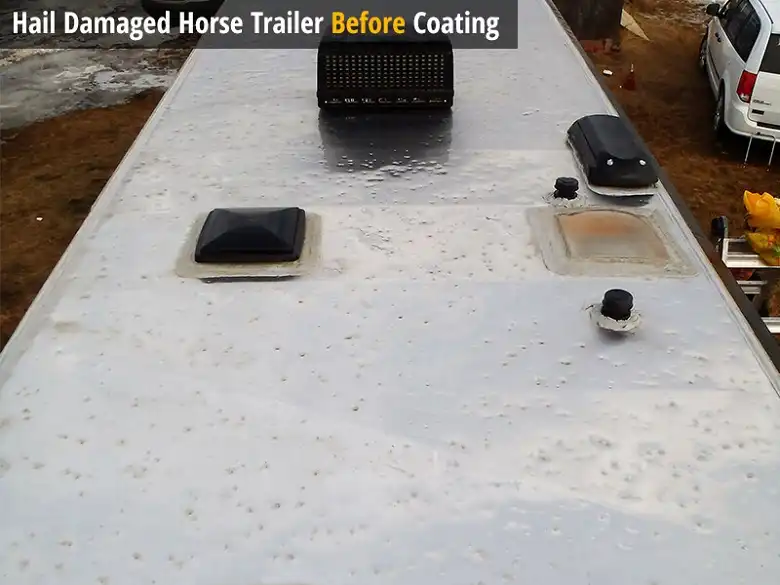
Hood
The hood bears the brunt of frontal hail impact as storms roll through. As few as 10-20 hail dents within a concentrated area of the hood can prompt the insurance company to total a camper. Since this section incorporates the windshield, it compromises visibility and safety if severely damaged.
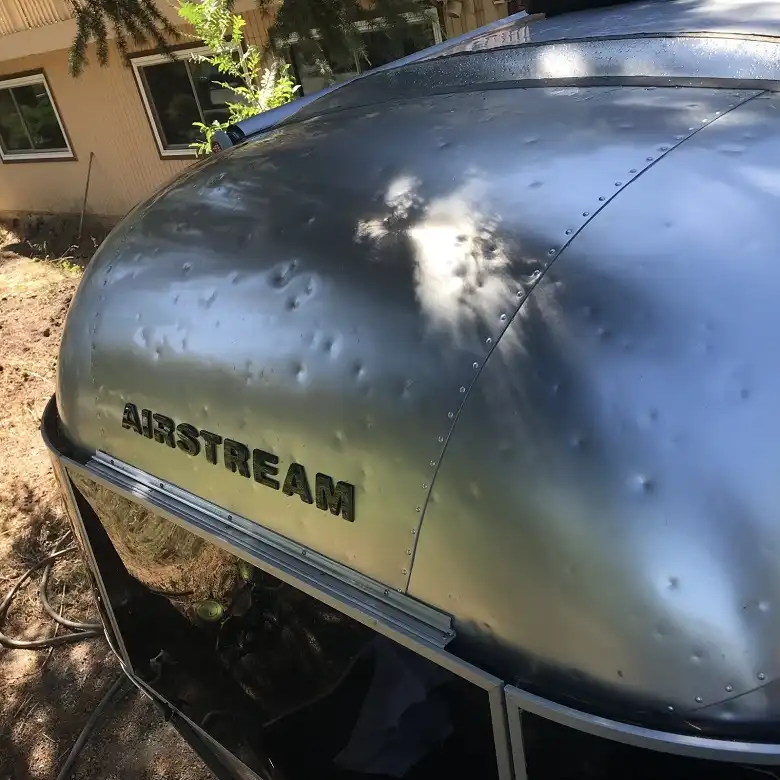
Slide-Out Sections
Slide-outs contain rubber seals, mechanisms, and walls that are easily damaged by hail. If the slides are comprehensively dented, leak, or no longer function properly, repairs can be extremely costly. As few as 5-10 concentrated hail dents may lead to the slides and camper being totaled.
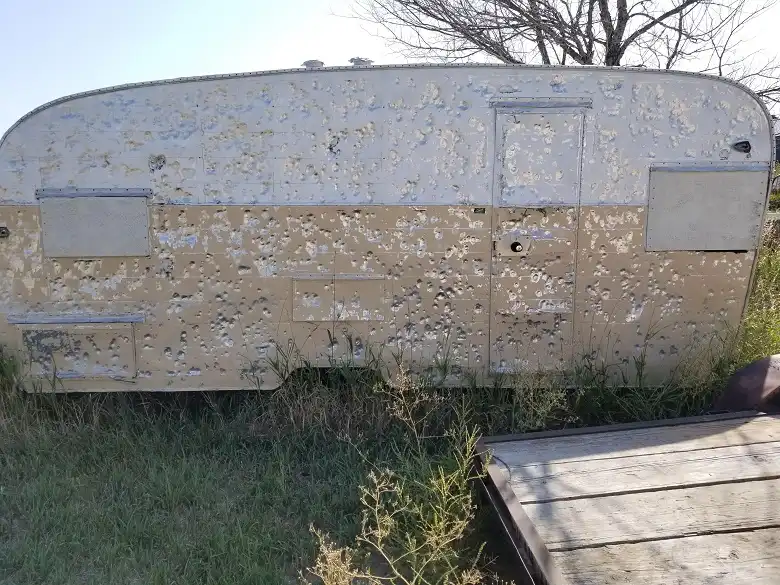
Siding
Consistent hail damage across more than 50% of the siding is often the tipping point for totaling a camper. Repainting or replacing extensively damaged metal or fiberglass panels is labor-intensive. Dents that warp siding and expose insulation must be addressed to prevent water intrusion.
If holes are created on the sides, the interior wall structure and wiring may also be compromised. Excessive repairs will exceed the RV’s worth.
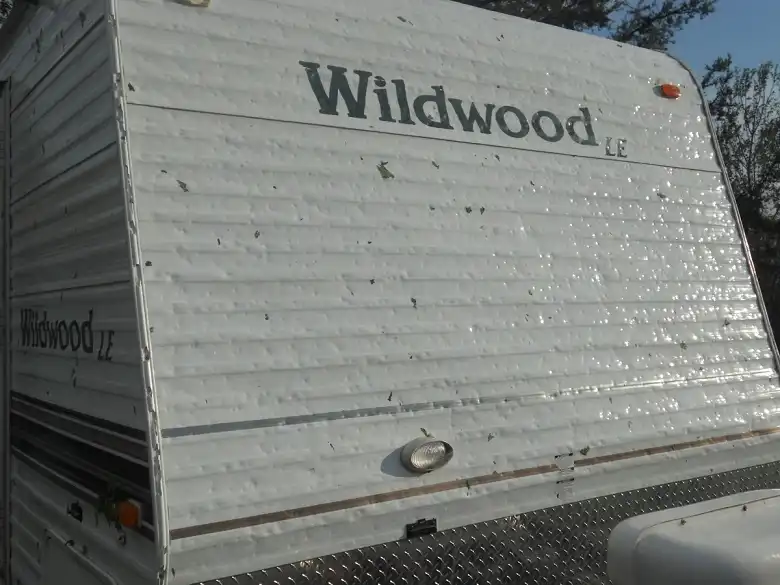
Other Factors That Could Total Your Camper
Aside from dents and holes, hail can cause other issues that may total a camper:
- Window damage – Shattered windows from hail must be replaced and water sealing reapplied. Just a few broken windows can lead to a total loss.
- AC unit damage – Dents to the AC shroud and fins disrupt air flow and cooling. AC repairs average $1500 or more.
- Skylight damage – Cracked and broken skylights caused by hail create water intrusion points into the RV interior. Breached roof seals can lead to totaling.
- Awning damage – Vinyl awnings shredded by hail are costly to replace. Structural awning mounts may also be bent by hail.
- Mold/mildew – Water leaks from hail damage can quickly cause mold in walls and ceilings. This challenging and expensive issue may prompt a total loss.
- Compromised structure – Large widespread dents that warp RV sides or crush structural frame members will likely exceed repair costs.
How to Inspect and Assess Hail Damage on Your Camper
If you own a camper damaged by hail or are looking to purchase one at a discounted price, keep these tips in mind when inspecting:
Step 1: Closely check the roof for hail damage, paying special attention to AC units, vents, and skylights. Look for cracks in sealant around fixtures.
Step 2: Inspect slide-out sections for dents or functionality issues. Test all slides to ensure they open and close properly.
Step 3: Any shattered, cracked, or chipped windows should be replaced and resealed. Inspect window frames and seals for damage.
Step 4: Note any warped or misshapen areas on RV sides, which indicate more severe underlying damage. Look for ripples, indentations, and holes.
Step 5: Water stains or damp areas inside the camper may signal leaks from hail impacts. Be alert for any mildew smells.
Step 6: Carefully inspect fiberglass or painted exteriors for chips, fractures, scratches, and scuffs from hailstorms.
Step 7: Evaluate the hood and windshield thoroughly for cracks or visibility obstructions from hail dents.
Step 8: Consult your insurance company if unsure whether the damage will exceed repair costs and prompt a total loss. Their adjusters can provide an accurate assessment.
Being aware of these potential problem areas will help you evaluate the scope of damage and decide if an RV is worth purchasing and repairing after the hailstorm. Carefully consider the costs involved before committing to significant hail repairs.
Is Hail Damage Covered by RV Insurance?
If your RV is damaged in a hailstorm, comprehensive coverage will pay for repairs or total loss replacement. This covers damage from natural disasters like hail, floods, windstorms, and earthquakes.
Most policies have deductibles of around $500 – $1000 for comprehensive claims. It’s important to take detailed photos and document all damage before filing a claim. Work with your insurer and come to an agreement on the repair plan.
For used RVs with prior hail damage, it gets trickier. Some insurers may exclude existing damage from coverage. Definitively proving when dents occurred is difficult. Discuss any undiscovered hail damage found after purchase with your agent to review policy specifics.
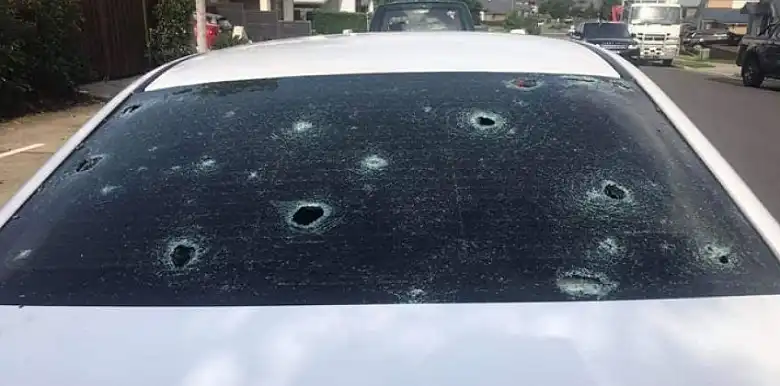
Should You Repair or Total a Camper with Hail Damage?
Once you’ve thoroughly assessed the hail damage with your insurer, deciding whether to repair or total loss the RV depends on several factors:
Cost of repairs – Obtain an accurate estimate for the work needed. Extensive roof repairs, new siding, slide work, and window replacements can exceed thousands. Each dent or scratch must be addressed to prevent leaks or rust. If repair costs approach the ACV value of the RV, it may reach total loss territory.
RV value – Is it a brand new $100k rig or a 20-year-old model worth $5k? You don’t want repair bills equaling a major portion of the RV’s value.
Availability of parts – For an older RV, replacement panels and windows may be hard to source. Better to total than pay for custom fabrication work.
Insurance deductible – If your deductible is $2500 for example, and repairs are $5000, it may be better to pay the total loss of the rig than pay out of pocket beyond the deductible.
Severity of damage – Can dented areas properly be repaired and sealed? Or is damage too extensive for effective repairs? Severe damage often leads to total loss.
Resale value – Even with repairs, heavy hail damage can hurt resale value down the road. The rig’s worth may be too compromised to justify repairs.
Carefully weighing these factors will help determine if you should repair or total the loss of your hail-damaged RV. The damage threshold for totaling varies widely based on circumstances.
Can You Still Use a Hail-Damaged Camper?
For moderate or minimal hail damage, you can likely continue camping with proper repairs. But for severe damage:
- Avoid towing until an assessment is made. The structure may be unsafe.
- Do not stay in the RV if windows or openings are compromised from hail impacts.
- Watch for water leaks indicating possible damage, and mitigate any issues immediately.
- Operate ACs and slides carefully. Stop if odd noises or errors occur which could exacerbate damage.
- Avoid harsh weather if the RV roof and seals may be weakened from hail strikes.
It’s generally not advisable to use an RV with extreme hail damage until repairs can be made. Consult your insurance agent for specific guidance based on your unique situation.
How to Protect Your RV from Hail Damage Before a Storm
When a hailstorm is forecast, proactively protect your RV:
- Move the RV indoors or under cover if possible. Aim to shield the roof and hood.
- Install protective awnings or screens above the RV if outdoor storage is unavoidable.
- Use tarps or canvas covers secured around the camper’s exterior. Avoid lightweight sheets that can shred in hail.
- Park under bridges, overpasses, or dense tree areas that provide shelter from hail.
- Elevate slide toppers and apply reinforcement where possible. Bring in exterior furniture and accessories.
- Check your policy limits and deductibles if unable to avoid the storm. Call your agent with any questions.
- Take photos/video of the RV pre-storm to document the condition for any insurance claims needed.
Stay alert to storm warnings and take proactive measures to shield your RV investment from hail damage as much as possible.
Finding RV Hail Repair Specialists: What to Look For
For significant hail damage, the best option is hiring an RV restoration company specializing in hail repairs:
- Ask your insurance provider for recommended vendors who handle RV hail claims.
- Search for “RV hail repair near me” and vet companies based on experience, reviews and certifications. Mobile repair services can come to your vehicle.
- Look for established vendors using laser scanning and computerized dent mapping for precision work.
- Ask about paintless dent repair techniques that push dents out from behind vs pulling which can warp panels.
- Inquire if they use manufacturer-approved materials and parts for RV restoration work.
- Review sample before and after photos of similar RV hail repairs completed.
- Get a detailed written estimate, timeline, and warranty provided upfront. Avoid vague verbal commitments.
Reputable mobile techs have the training, tools, and expertise to restore RVs properly. Avoid DIY repairs on fiberglass or critical areas. Hire professionals for quality hail damage repair work.
Frequently Asked Questions
How Many Dents From Hail To Total An RV?
There’s no set number of hail dents that automatically mean the camper is totaled. It depends on the size and concentration of dents, and which parts of the RV are impacted. As a general rule, if more than 50% of the overall roof, hood, sides, or slideouts have extensive hail damage, the repair costs may exceed the value of an older RV and lead to a total loss.
Does Minor Hail Damage Need To Be Repaired?
Even small hail dents and chips should be addressed to prevent corrosion and water intrusion issues. Applying touch-up paint to chips and properly sealing any small penetrations can go a long way in preserving your RV investment. Larger dents may require professional PDR, sealants, or panel replacements.
How Much Does It Cost To Repair Hail Damage On An RV?
Minor scratches or small dents cost $100 or less to fix. Repainting damaged sections averages $500 and up. Significant roof or siding repairs can run $2000-$5000 or more. If slideouts, windows, or appliances need replacement, that can add thousands to the cost. Total repair bills vary drastically based on damage severity.
Will Fixed Hail Damage Hurt My RV’s Value?
Yes, even fixed hail damage hurts resale value and trade-in offers. Minor damage may lower value by 5-15%, while extensive repairs can decrease RV worth 25% or greater. Providing repair documentation helps maximize value, but hail history still negatively impacts price.
Can I Avoid My RV Insurance Going Up After A Hail Claim?
Filing a hail damage claim can increase your premiums at renewal time. To minimize the rate hike, choose a higher deductible since it signals lower risk. Ask about claim forgiveness options and policy discounts. Improve security features to demonstrate the RV is better protected. Shop quotes to find the best rate after a claim.
Conclusion
Hail storms are unpredictable and can happen almost anywhere. As an RV owner, it’s critical to educate yourself on the damage hail can cause, and what it takes to total a camper. Factors like hail size, density of strikes, repair costs, and age of the rig all come into play during the insurance claims process.
While there are general guidelines regarding hail dent concentrations and severity, each situation is unique. Work closely with your insurance adjuster to reach an agreement on whether repairs make financial sense, or if the damage warrants deeming your RV a total loss. Hopefully, this article provided helpful insights into evaluating hail damage on your RV.
Let me know in the comments if you have any other questions on this important topic for RV owners. Thanks for reading and happy trials!

